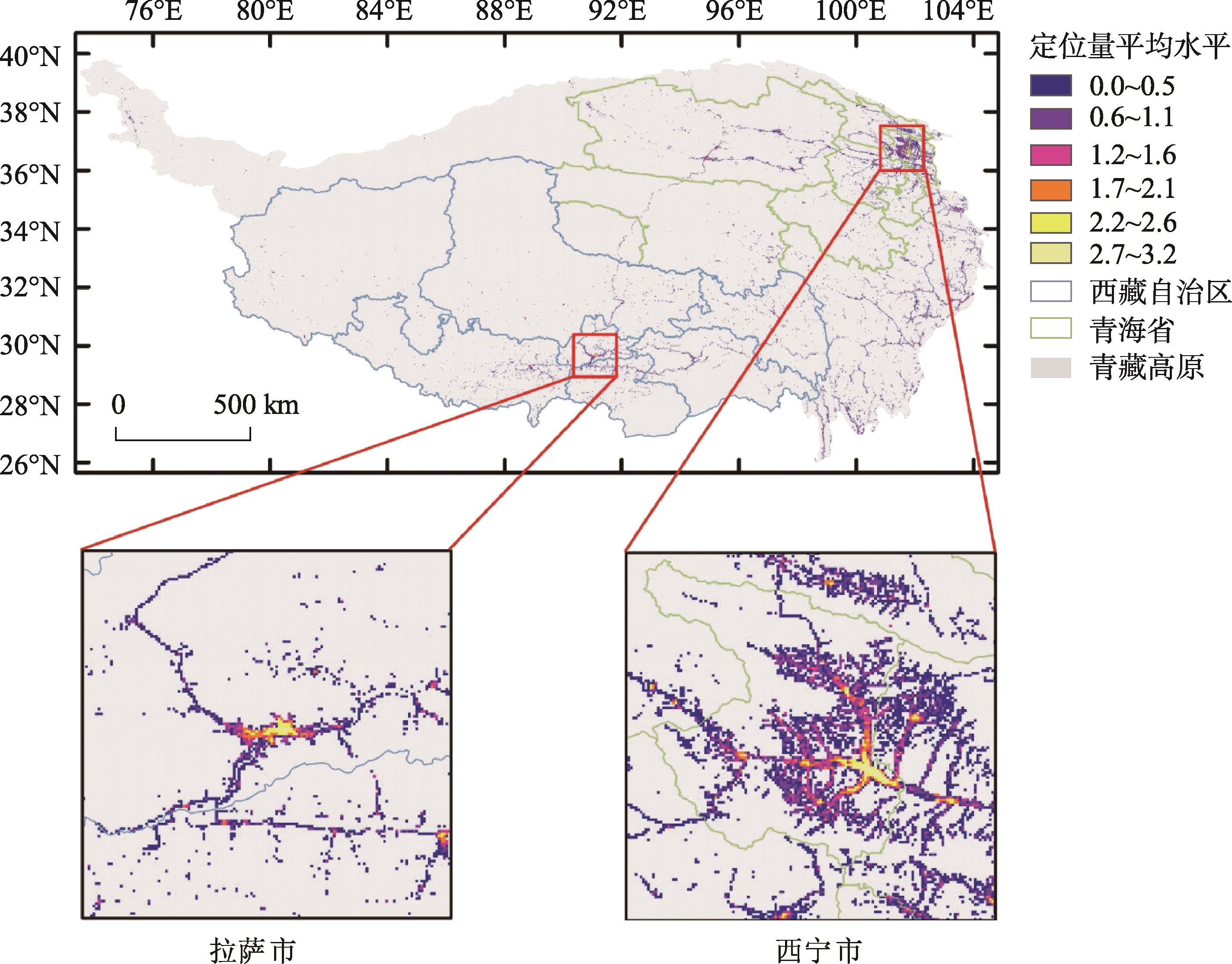

Journal of Geo-information Science >
Spatiotemporal Pattern of Population Distribution in the Qinghai-Tibet Plateau during the National Day Holidays: Based on Geospatial Big Data Mining
Received date: 2019-02-15
Request revised date: 2019-06-25
Online published: 2019-09-24
Supported by
the Strategic Priority Research Program of the Chinese Academy of Sciences, No.XDA19040501(XDA19040501)
The Strategic Priority Research Program of the Chinese Academy of Sciences(XDA20040401)
National Key Research and Development Program of China(2017YFB0503605)
National Key Research and Development Program of China(2017YFC1503003)
Copyright
Human activities play an important role in transforming the eco-environment of the Qinghai-Tibet Plateau (QTP). Extensive studies have been conducted on the human activities in the prehistoric QTP and on population distribution and migration in the recent decades, yet, most of them rely on limited demographic materials of coarse spatial resolutions. It remains understudied regarding the fine-scale spatiotemporal pattern of human distribution in the QTP. In this context, geospatial big data generated from ubiquitous mobile communication technology and internet provide a great opportunity to investigate the dynamic human distribution at very fine scales. This study took the advantage of the geospatial big data, including the mobile phone location requests (LR) and population migration, and employed time series decomposition and anomaly detection approaches to explore the population distribution changes in the QTP during the 2017 National Day holidays. Results show that, at the provincial and prefectural scales, Qinghai, Tibet, and their provincial cities exhibit a featured "tidal change" pattern that the LR first decreased then increased. Such fluctuation in Qinghai were stronger than that in Tibet, and cities in the same province demonstrated significant differences. At the grid scale, the LR in the surrounding areas of Xining and Lhasa displayed a spatially “decentralized pattern” that the LP dropped in the central areas yet increased in the peripheral. Based on the anomaly detection approach, we found the number of anomaly grids and deviation magnitude increased in Xining, Haidong, Haibei, Hainan, and Huangnan of Qinghai since the holiday. More positive anomalies were observed than the negative ones, and the negative anomalies were concentrated in cities of large population densities such as Xining and Lhasa. Further analysis combining the population migration data reveals that the travel behaviors potentially drove people swarming to the nearby scenic spots and that the massive migration between cities was an important reason for the increase of LR in areas surrounding Xining and Lhasa. The decrease of LR in the central areas of cities could be partly attributed to significant population migration, but the different daily routines and location request frequencies during holidays may also be important reasons. Our findings demonstrate the potential of using geospatial big data to improve our understanding of human distribution and migration, which could further support fine management and decision-making for plateau urbanization and ecological protection.

YI Jiawei , DU Yunyan , TU Wenna . Spatiotemporal Pattern of Population Distribution in the Qinghai-Tibet Plateau during the National Day Holidays: Based on Geospatial Big Data Mining[J]. Journal of Geo-information Science, 2019 , 21(9) : 1367 -1381 . DOI: 10.12082/dqxxkx.2019.190067
图3 西宁市及周边2017年国庆期间定位量趋势距平值变化情况注:图中折线图为城市中心0.1度范围内的平均趋势距平值变化,横坐标为距离城市中心点的网格距离/km,纵坐标为趋势距平值。 Fig. 3 Trend change (Di) of location requests in Xining and surrounding areas during the 2017 National Day festival |
图6 青海省及其地级行政单元国庆假期定位请求数据点异常检测及分析结果Fig. 6 Detection and analysis of the point anomalies in location requests of Qinghai and subordinate prefectures during the National Day festival |
图8 热门景点及主要通往道路2017年国庆假期定位量趋势变化注:S1到S10为所选的10个旅游景点位置,P1到P5为通往上述景点的主要旅游路线。 Fig. 8 Trends of the location requests in the major scenic hotspots and roads during the 2017 National Day festival. The ten selected scenic hotspots are marked by dots, S1 to S10, and the major tourist roads to these scenic spots are marked by lines, P1 to P5 |
| [1] |
陈发虎, 安成邦, 董广辉 , 等. 丝绸之路与泛第三极地区人类活动、环境变化和丝路文明兴衰[J]. 中国科学院院刊, 2017,32(9):967-975.
[
|
| [2] |
刘荣高, 刘洋, 徐新良 , 等. 近30年青藏高原南缘地理环境状况及变迁研究[J]. 中国科学院院刊, 2017,32(9):1003-1013.
[
|
| [3] |
姚檀栋, 陈发虎, 崔鹏 , 等. 从青藏高原到第三极和泛第三极[J]. 中国科学院院刊, 2017,32(9):924-931.
[
|
| [4] |
张宪洲, 杨永平, 朴世龙 , 等. 青藏高原生态变化[J]. 科学通报, 2015,60(32):3048-3056.
[
|
| [5] |
樊杰, 徐勇, 王传胜 , 等. 西藏近半个世纪以来人类活动的生态环境效应[J]. 科学通报, 2015,60(32):3057-3066.
[
|
| [6] |
陈发虎, 刘峰文, 张东菊 , 等. 史前时代人类向青藏高原扩散的过程与动力[J]. 自然杂志, 2016,38(4):235-240.
[
|
| [7] |
侯光良 . 青藏高原的史前人类活动[J]. 盐湖研究, 2016,24(2):68-74.
[
|
| [8] |
郭兵, 孔维华, 姜琳 , 等. 青藏高原高寒生态区生态系统脆弱性时空变化及驱动机制分析[J]. 生态科学, 2018,37(3):96-106.
[
|
| [9] |
|
| [10] |
|
| [11] |
王超 阚瑷珂, 曾业隆 , 等. 基于随机森林模型的西藏人口分布格局及影响因素[J]. 地理学报, 2019,74(4):664-680.
[
|
| [12] |
杨成洲 . 高原民族地区人口流动特征与模式研究—基于西藏自治区的考察[J]. 干旱区资源与环境, 2019,33(7):43-48.
[
|
| [13] |
吴江, 张秀香, 叶玲翠 , 等. 不同时间尺度周期的旅游客流量波动特征研究——以西藏林芝市为例[J]. 地理研究, 2016,35(12):2347-2362.
[
|
| [14] |
陆锋, 刘康, 陈洁 . 大数据时代的人类移动性研究[J]. 地球信息科学学报, 2014,16(5):665-672.
[
|
| [15] |
牛方曲, 刘卫东 . 基于互联网大数据的区域多层次空间结构分析研究[J]. 地球信息科学学报, 2016,18(6):719-726.
[
|
| [16] |
赵梓渝, 魏冶, 庞瑞秋 , 等. 中国春运人口省际流动的时空与结构特征[J]. 2017,36(8):952-964.
[
|
| [17] |
吴吉东, 王旭, 王菜林 , 等. 社会经济数据空间化现状与发展趋势[J]. 地球信息科学学报, 2018,20(9):1252-1262.
[
|
| [18] |
|
| [19] |
潘碧麟, 王江浩, 葛咏 , 等. 基于微博签到数据的成渝城市群空间结构及其城际人口流动研究[J]. 地球信息科学学报, 2019,21(1):68-76.
[
|
| [20] |
张晓瑞, 华茜, 程志刚 . 基于空间句法和LBS大数据的合肥市人口分布空间格局研究[J]. 地理科学, 2018,38(11):1809-1816.
[
|
| [21] |
|
| [22] |
|
| [23] |
段玉珊, 王娜 . 西藏人口城镇化进程及发展趋势预测[J]. 西藏研究, 2015(4):67-74.
[
|
| [24] |
张宇, 曹卫东, 梁双波 , 等. 西部欠发达区人口城镇化与产业城镇化演化进程对比研究——以青海省为例[J]. 经济地理, 2017,37(2):61-67.
[
|
| [25] |
国家统计局. 中国统计年鉴2018[M]. 北京: 中国统计出版社, 2018.
[ National bureau of statistics. China statistical yearbook 2018[M]. Beijing: China Statistics Press, 2018. ]
|
| [26] |
丁生喜, 王晓鹏, 秦真凤 , 等. 基于人口-经济-生态协调发展的青海省新型城镇化研究[J]. 生态经济, 2015,31(3):74-77.
[
|
| [27] |
史晨怡, 周春山, 余波 . 援藏与西藏自治区城镇化的耦合协调分析[J]. 世界地理研究, 2018,27(3):42-54.
[
|
| [28] |
王胡林 . 改革开放40年西藏城镇化发展的回顾与展望[J]. 西藏研究, 2018,( 5):123-132.
[
|
| [29] |
魏巍 . 西藏国庆节期间接待国内外游客120万余人次[N/OL]. 中国新闻网, 2017- 10- 09.
[
|
| [30] |
赵彤彤, 宋邦国, 陈远生 , 等. 西藏一江两河地区人口分布与地形要素关系分析[J]. 地球信息科学学报, 2017,19(2):225-237.
[
|
| [31] |
|
| [32] |
|
| [33] |
|
/
| 〈 |
|
〉 |